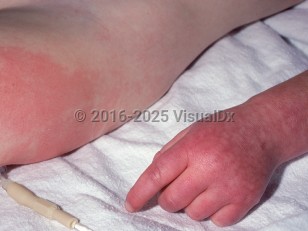Familial dysautonomia, also known as hereditary sensory and autonomic neuropathy (HSAN) type 3 or Riley-Day syndrome, is a rare genetic disorder. Most affected individuals are of Ashkenazi Jewish ancestry, and it affects 1 in 3700 Ashkenazi Jews in North America. It is caused by an autosomal recessive mutation in the IKBKAP gene.
Symptoms usually start in infancy with poor feeding and growth, hypotonia, lack of tears, difficulty controlling body temperature, and frequent lung infections due to aspiration. The condition is characterized by decreased pain and temperature sensation along with dysfunction of the sympathetic nervous system. Patients develop fluctuations in blood pressure and heart rate, orthostatic hypotension, and other cardiac conduction abnormalities. Autonomic crises may occur after emotional or physical stress and are characterized by hypertension, tachycardia, sweating, flushing, drooling, and vomiting. The condition is also associated with decreased fungiform papillae on the tongue, absence of tears, scoliosis, impaired kidney function, and vision loss from optic atrophy. Gait ataxia is common, often leading to the need for assistive walking devices.
There is currently no cure for this condition. Management includes treatment of complications, particularly respiratory disease and dysphagia. Prognosis is poor, and only half of those affected live to age 20. Respiratory disease is the most common cause of death.
Related topic: Hereditary sensory and autonomic neuropathies
Familial dysautonomia in Adult
Alerts and Notices
Important News & Links
Synopsis

Codes
ICD10CM:
G90.1 – Familial dysautonomia [Riley-Day]
SNOMEDCT:
29159009 – Familial Dysautonomia
G90.1 – Familial dysautonomia [Riley-Day]
SNOMEDCT:
29159009 – Familial Dysautonomia
Look For
Subscription Required
Diagnostic Pearls
Subscription Required
Differential Diagnosis & Pitfalls

To perform a comparison, select diagnoses from the classic differential
Subscription Required
Best Tests
Subscription Required
Management Pearls
Subscription Required
Therapy
Subscription Required
References
Subscription Required
Last Reviewed:07/25/2019
Last Updated:01/16/2022
Last Updated:01/16/2022
Familial dysautonomia in Adult

